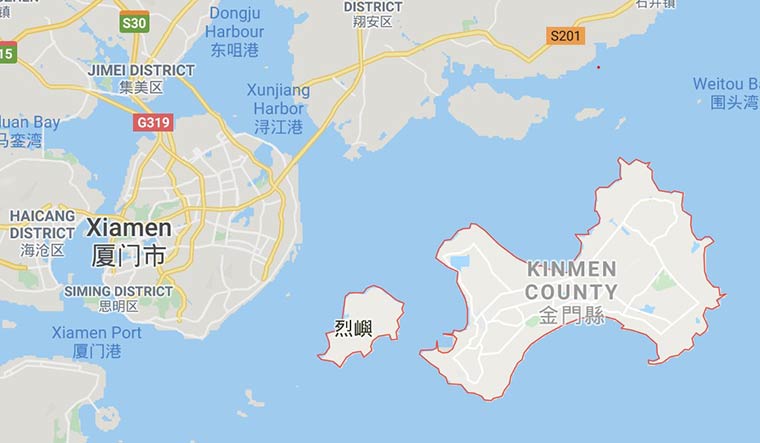In a bizarre incident, a Chinese man revealed on July 24 that he swam 10 hours to reach Taiwan’s Matsu Islands in order in what he calls his quest to “seek freedom.”
The incident was reported in Beigan Township on Beigan Island, the second-largest island in Matsu, officially Lienchiang County when a Chinese citizen in his 40s asked for aid from tourists close to the Qinbi Broadcasting Station after being stung by a bee, Taiwan News reported.
When the county authorities responded to the tourists’ call, they discovered the man was an unauthorized Chinese immigrant. Since the illegal immigrant’s injuries weren’t considered to be significant, he was taken to the Beigan health center for treatment.
According to authorities, the man had packed his clothing, medicine, dry food, and Chinese currency. He said he had swum 10 hours from Huangqi Peninsula in China’s Fujian Province to Taiwan’s Matsu Islands to “seek freedom.”
Google Maps estimates the distance between the Huangqi Peninsula and Matsu’s Beigan Township to be 12 kilometers in a straight line. Authorities moved the person to the Lienchiang District Prosecutors Office to investigate whether they violated the Act Governing Relations Between the People of the Taiwan Area and the Mainland Area.
The Republic of China (Taiwan) administers the 36-island archipelago known as the Matsu Islands, located off the southeast coast of Mainland China and part of the East China Sea.
The People’s Republic of China (PRC) took control of the county’s mainland portion after the Chinese Civil War, while the outlying islands of Matsu were kept under ROC rule.
The current Lienchiang County of the ROC was formerly part of an intact Lienchiang County of Fujian. Due to the circumstances, the county is the only previous geographic area with the same name currently administered by the ROC and the PRC.
#Day2 of #HanKuang39thExercise at Bali Beach, the Third Theater Command carried out battlefield management & force protection, while the 53rd Engineer Group set up obstruction facilities for different infantry and firepower requirements to impede enemy landing operations.🇹🇼 pic.twitter.com/wA4mGxqOcy
— 國防部 Ministry of National Defense, R.O.C. 🇹🇼 (@MoNDefense) July 25, 2023
The incident comes at a time of increased tensions between the People’s Republic of China and the Taiwanese island, with Beijing reiterating its vows of uniting the self-ruled island state with the Chinese mainland. High-ranking Chinese officials assert that Taiwan is a rogue province that must be unified with the mainland.
Against that backdrop, the Chinese military has ramped up its military activity in what is usually referred to as its “gray zone tactics.” Taiwan has also been working to bolster its combat capability to avert such an eventuality. The recent incident comes when Taiwan is conducting its biggest Han Kuang 39 military drills focusing on deterring China.
However, this is not the first time a Chinese citizen has attempted to escape to freedom. There have been several instances where fleeing what they call a restrictive way of life devoid of civil liberties, Chinese citizens have tried to cross over to Taiwan and Hong Kong by illegal means.
Not The First Time
In 2020, a 45-year-old man was detained by Taiwan’s Coast Guard after swimming from the Chinese coastal city of Xiamen to the offshore Taiwanese island of Kinmen County after reports of a “suspicious object” drifting close to the Kenmen County seas were reported by locals.
The man, who went by Li, claimed that he swam seven hours to get to Kinmen because he could not abide the political climate in China and wanted to go to Taiwan to support its independence.
Chinese nationals have frequently attempted to swim to Kinmen, just over 10 miles or about 16 kilometers off the coast of Xiamen. Since the coronavirus outbreak, this incident was the first instance of unauthorized sea migration.

In fact, a Xiamen-Kinmen Cross-Strait Swimming Race exists, a competition for people who dare to cross the straits to strengthen ties between China and Taiwan. The main island of Taiwan is located just 200 kilometers from China’s coast, making this adventurism a reality.
This month, the competition was resumed years after it was suspended in 2020 in the wake of Covid-19.
In 1949, the Kuomintang (Republic of China nationalists) defeated the Communist forces attempting to seize Kinmen as part of plans to launch a bigger invasion of Taiwan at the Battle of Kuningtou in Kinmen. This is one of the reasons why this region in Taiwan is particularly significant.
According to reports, after China imposed severe lockdowns and restrictions in the wake of increasing coronavirus cases, there has been an uptick in the number of people wanting to leave the country. From the start of 2022, stringent lockdowns were implemented in numerous Chinese cities, including Shanghai, sparking concerns and criticisms.
The Chinese economy was severely impacted, and recent graduates lamented their inability to find employment. Although the economy showed signs of recovery in June, after discovering the more contagious Omicron subvariant, BA.5, many questioned whether further lockdowns in major cities like Shanghai are imminent.
Urban Chinese individuals who lost hope began making plans to escape the nation. Soon after, “run philosophy” or “run xue” gained popularity on Chinese social media as a catchphrase for emigrating.
Last summer, forums were created on Chinese-language social media to trade advice on increasing the chances of admission to international academic institutions. According to immigration services, the number of business requests skyrocketed during that period.
Having said that, while the lockdowns were slowly lifted and the economic slowdown has slowly faded, incidents of some citizens escaping to what they call “freedom” continues to be reported and sometimes illegally.
In the recent incident, the details about the man trying to cross over to Taiwan have not been revealed.
- Contact the author at sakshi.tiwari9555 (at) gmail.com
- Follow EurAsian Times on Google News